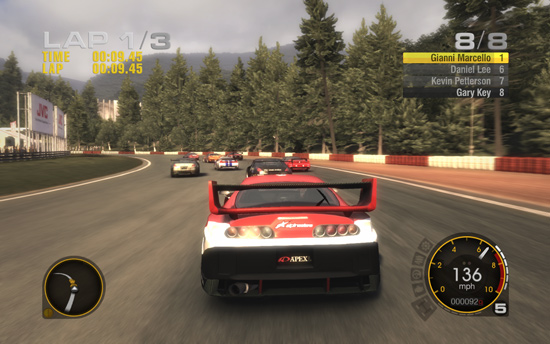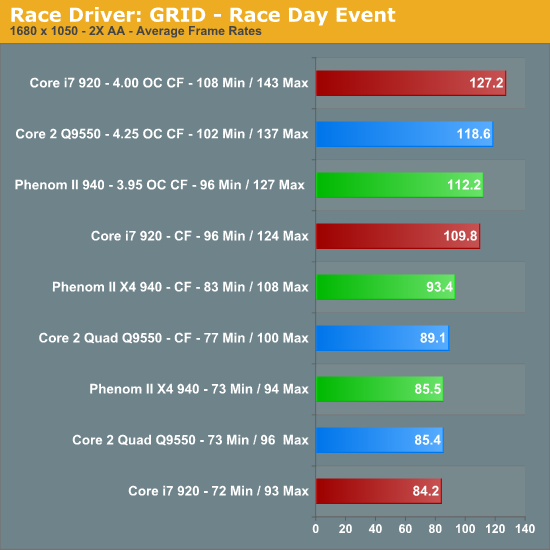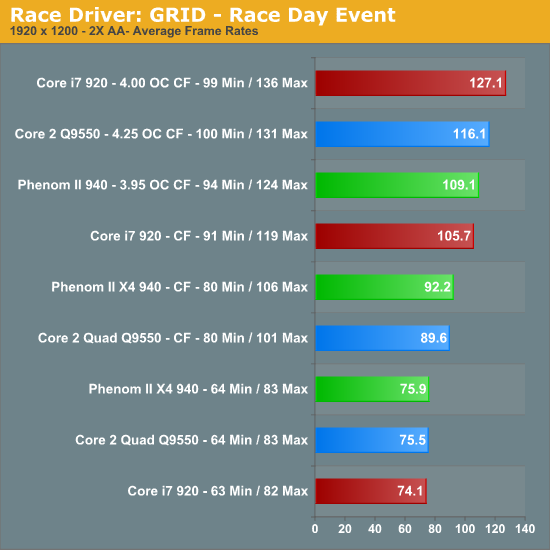CrossFireX and the Phenom II X4 940 – Competitive or Not?
by Gary Key on February 2, 2009 12:00 AM EST- Posted in
- Motherboards
Race Driver: GRID

The more serious racing fans on the staff tend to end up at iRacing.com or playing a modified version of Grand Prix Legends for our racing simulation fix. However, there comes a time to throw out physics and just have some fun. In that case, GRID is the game we play. We turn up all the options, set AA to 2x, and let the rubber burn in a Race Day event. Our results are captured via FRAPS.

At 1680x1050 in single card mode, we are GPU limited. All three platforms have close scores, but the Phenom II 940 does get a win here. The Phenom II leads the Q9550 by 4% in CrossFire average frame rates and 7% in minimum frame rates. The tables are reversed once we overclock the processors as the Q9550 has a 5% advantage in average frame rates and 6% in minimum frame rates, both close to the 7% clock speed advantage for the Q9550. The i7 runs like a Ferrari once we introduce CrossFire and overclocking into the benchmarks as it easily surpasses the other two platforms.
Adding a second card for CrossFire operation improves average frame rates by 21% and minimum frame rates by 25% for the Phenom II. The Intel Q9550 has an improvement of 19% in average frame rates and 25% in minimum frame rates. The Core i7 average frame rates improve by 42% and minimum rates increase 44%. Overclocking our processors resulted in an 18%~30% average improvement in average frame rates with the Q9550 benefiting the most.

Turning the resolution up to 1920x1200 has us playing the same old record. The results follow the pattern set at 1680x1050. The Phenom II scores another win here in single card and CrossFire mode over the Q9550. The Core i7 continues to dominate the benchmarks although the Phenom II continues to make a very good showing in minimum frame rates.
Adding a second card for CrossFire operation improves average frame rates by 9% and minimum frame rates by 14% for the Phenom II. The Intel Q9550 has an improvement of 5% in average frame rates and 5% in minimum frame rates. The Core i7 average frame rates improve by 30% and minimum rates increase 33%. Overclocking our processors resulted in an 18%~32% average improvement in frame rates for our collective group with the Q9550 benefiting the most.
Once again, our game play experience indicates there is no difference between the three platforms at our settings. Although frame rates were higher with the i7 in CrossFire mode, there was no appreciable difference in game play quality.










68 Comments
View All Comments
balancedthinking - Monday, February 2, 2009 - link
If these Settings were used for the Phenom II 940, at least it is not as bad as I first thought:http://www.anandtech.com/weblog/showpost.aspx?i=55...">http://www.anandtech.com/weblog/showpost.aspx?i=55...
That would mean an NB frequency around 2450. That is quite okay though it can be tweaked a bit further.
Still, it would be nice to know which settings were actually used for the Phenom II.
hooflung - Monday, February 2, 2009 - link
That is a very, very well done article. Keep it up guys. Can't wait til' income tax and I am going to get a e8500 and a pII 940 to upgrade my P35 and 790GX, respectively.7Enigma - Monday, February 2, 2009 - link
Thank you for finally including this information in the charts!This has been a HUGE peev of mine for a while now and it really helps to see which card (or in this case system) is actually better than the other at a particular game where the average frame rate may not tell the whole story.
Please make sure the rest of the Anandtech crew starts using this format for future testing.
CPUGuy - Monday, February 2, 2009 - link
Although I understand the intent of using the highest OC possible I do believe the results can lead to another conclusion. A few of us discussing the CPU OC, CF results. It appears (so far) that the reason why the Q9550 came out ahead in CF results was a direct result of it's overclock. Some believe that if the PII 940 was OC'd that high (yes we read the other article about this) or the Q9550 was OC'd down, results would be different.The reason for this point of view is that most are not able to get Q9550 at 4.25GHz on air.
jusme - Monday, February 2, 2009 - link
I found this article very informative. It now puts into perspective where the PII 940 stands in the gaming arena. Thanks Anandtech for taking the time to do it. I myself have 3 computers, 2 capable of of either the quad 9550(P45) or PII 940 Deneb(780g). It is very good to know that which ever solution I choose, xfire on P45 or single on 780g, I know the performance capabilities of both, and I like both. Hell, you got that Q9550 up to 4.05 oc for these tests? Wow! I knew they were capable, but to run these games that well under the load is alone impressive. You sure it was'nt the Q9650? I alone was going to shoot for a modest 3.8 for gaming, stability and temp management. In closing, it is also good to know that those who jumped on the I7 bandwagon real fast are sitting pretty, I know it was'nt cheap, but alot of those builders skimped on graphics.zenguy - Monday, February 2, 2009 - link
In your review, it you stated that your testing did not reveal any difference between the P45 and P48 for CrossFire Limits so a P45 board was chosen.However, based on a few other reviews I have read, the 4850 can be noticably limited by the P45 board and ergo I presume the limits on a 4870 1GB card would be much much higher.
An example of one such review is below...........
http://www.tweaktown.com/articles/1472/10/intel_p4...">http://www.tweaktown.com/articles/1472/...s_x48_cr...
Could this explain the "Unusual Drop" in performance or unexpected low framerates for the Intel Platform that you noted?
AtenRa - Monday, February 2, 2009 - link
I am 100% sure that the results of the Core 2 Quad 9550 wild be much higher with an Intel X48 chipset than with the P45 in Cross Fire.Never the les, the article DOES show that Phenom II 940 is competitive in real life gaming at High resolutions.
zenguy - Monday, February 2, 2009 - link
Yes the PII is a valid solution.AMD Finally re-entered the game in my Mind with the release.
SLI - Monday, February 2, 2009 - link
Hammonds famous line in Jurrasic Park.Indeed, for 95% of folks, these ultra high benchmarks are useless. But for those of us in the 5%, thesy serve as a reminder on the ridiculous amounts of money we spend to squeeze just tha extra few FPS out. But then again the other 95% just dont get it...why?
Here is a paragraph I have kept near and dear for some years and it explains it eloquently.
"To upgrade or not to upgrade, that is the question that crosses many enthusiasts' lips on a daily basis. The upgrade bug is a high infectious, wallet-stripping disease that spreads fast once it gets a hold of you. Hardware manufacturers propagate this infection by offering you, the consumer, faster, more desirable hardware each month. Almost every facet of the hardware world begs you to get the next model up, or to break open the piggy bank and buy an 'upgraded version' of what you already have. Speak to a number of enthusiasts and they'll tell you that upgrading is more addictive than gambling (Biz387, 2003)."
So, you see, it's not our fault. Were simply sick. I type this as I play crysis at DX10 Very High spec everything at maximum @ 1900x1200@ 40fps average. Pulling about 830watts at the outlet, lol.
CPUGuy - Monday, February 2, 2009 - link
If I were to use your number, the inclusion of more mainstream benchmark results pulls in nearly 95% more hits to this website then it would be beneficial for both anandtech and it's viewer base. Puts things into prospective doesn't it? LOL